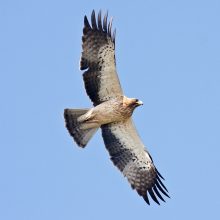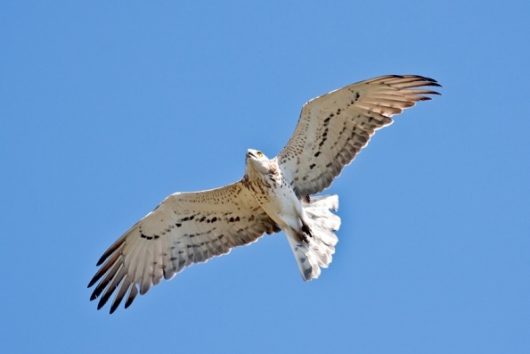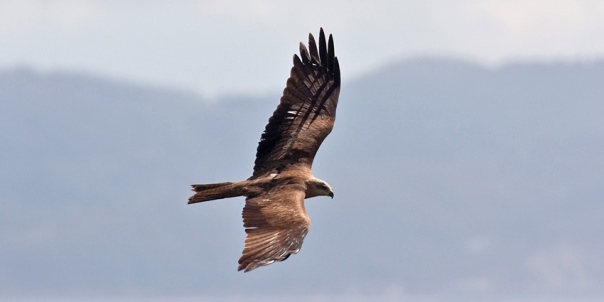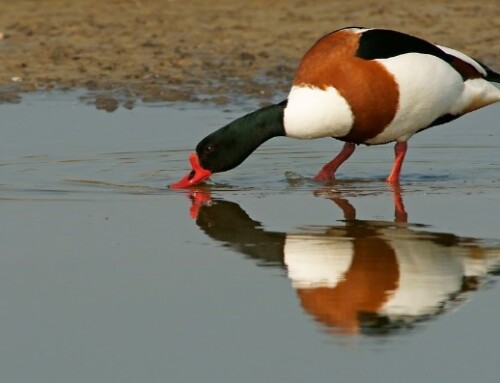Does the timing of migration reflect population trends of soaring birds?
LINKED PAPER
Long-term changes in autumn migration dates at the Strait of Gibraltar reflect population trends of soaring birds. Panuccio, M., Martín, B., Morganti, M., Onrubia, A. & Ferrer, M. 2016. IBIS. DOI: 10.1111/ibi.12420 VIEW
Climate is changing. Less clear are the effects of the changing environment on the biosphere, despite several studies that describe trends and risks as well as the first effects on organisms. Birds are widely studied as organisms that react to environmental changes, both because they are good model species and also because of conservation need. Migratory birds are most at threat, because of the risk of mismatch between the timing of breeding and that of food availability (Gienapp et al. 2008). If the spring peak of resources in the northern hemisphere is shifting, birds must adjust their timing in order to reproduce successfully (Kokko 1999, Møller 2007).
Some years ago Møller and colleagues (2008) highlighted that, among migratory songbirds, those species that are not advancing their migratory dates are declining throughout Europe. That one was of the first studies to show that bird species that are not “able to cope” with a changing environment are under unfavourable conservation status.

But what about migratory raptors and storks? Birds of prey have frequently been used as flagship or umbrella species (Sergio et al. 2006), as their presence is associated with high biodiversity (Sergio et al. 2005). Unfortunately, most raptor species are under threat due to habitat alteration and direct persecution. For this reason, most European raptor species are included under Annex I of the EU Birds Directive, while the Convention on the Conservation of Migratory Species of Wild Animals (CMS) deals with raptors specifically under the Memorandum of Understanding on the Conservation of Migratory Birds of Prey in Africa and Eurasia (Raptors MOU).
Until now there was a lack of knowledge on how Palaearctic raptors are responding to climate change. Jaffré et al. (2013) focused their research on short-distance migrant raptors, showing that when necessary they adjust their migration timing to regional weather conditions, resulting in less time spent away from the breeding sites. However, long-distance migrants cannot react quickly to the upcoming spring and therefore are more constrained in timing than short-distance migrants.

In our paper we analyzed the shift in the migration dates of eleven species of raptors and storks using data collected at the Strait of Gibraltar by Fundación Migres over 16 years. Data were collected with a huge field effort, making simultaneous observations from two watchsites every year from mid-July until mid-October. Moreover, we repeated the analysis on the data set collected along the same flyway at the Pyrenees, where it has already been shown that migratory raptors are advancing their autumn migration dates (Filippi-Codaccioni 2010). Counts of migrating soaring birds are a powerful tool to detect trends of migrants, as highlighted by several studies (Bildstein 2006, Agostini et al. 2007, Martin et al. 2016).

We first detected the magnitude of the shift for each species using Quantile Regression Analysis (Cade & Noon 2003). We considered three different phases of migration corresponding to different migration quantiles (10th, 50th, 90th), assuming that the median phase is representative of the main passage of adult birds, the last quantile is representative of the tail of migration, when most of migrants are juveniles, and the first quantile is representative of the passage of non-reproductive adults (mostly immature birds).

Then, to investigate species-specific shift in phenology, we used variables related to ecological and life-history traits in linear regression models, where the regression coefficients from the QR analysis were used as dependent variables. We used as predictors of the phenological shift the following variables: breeding population trend, trend of migration counts, breeding population size, northernmost breeding latitude, body mass, mean clutch size, duration of the breeding period, and generation length. We weighted models considering the phylogenetic relationships among the considered species (Rubolini et al. 2015) and we ran phylogenetically corrected models.

Our main result indicates that autumn migratory dates across the Strait of Gibraltar shifted significantly in ways that varied in magnitude and direction among different migration phases and species. Moreover the phylogenetically corrected linear models show that those species that experienced a positive population trend show the greatest advances in their autumn migratory dates. In other words, soaring bird species that are not “adjusting” their phenology to climate change are facing a decline throughout Europe.

We suggest that the rapid changes observed in migratory dates may result from a phenotypic response rather than from a micro-evolutionary process. This hypothesis is supported by the fact that the later phases of migration, when mostly juveniles migrate, are more stable, probably because inexperienced individuals are pushed south mostly by endogenous rhythms (Dawson et al. 2001).
Monitoring bird populations is a tool of paramount importance to identify the most sensitive species and we advocate once more for global conservation actions to preserve European raptors, which face an uncertain future, together with our environment.
References
Agostini N., Panuccio M., Mellone U., Lucia G., Wilson S. & Ashton-Booth J. 2007. Do migration counts reflect population trends? A case study of the Honey Buzzard, Pernis apivorus. Ardeola 54: 339-344. VIEW
Bildstein KL. 2006. Migrating raptors of the world. Ithaca, NY: Cornell Univ. Press.
Cade, B.S. & Noon, B.R. 2003. A gentle introduction to quantile regression for ecologists. Front. Ecol. Environ. 1: 412-420. VIEW
Dawson A., King V.M., Bentley G.E. & Ball G. F. 2001. Photoperiodic Control of Seasonality in Birds. J. Biol. Rhythms 16: 365-380. VIEW
Filippi-Codaccioni, O., Moussus, J.P., Urcun, J.P. & Jiguet, F. 2010. Advanced departure dates in long-distance migratory raptors. J. Ornithol. 151: 687-694. VIEW
Gienapp, P., Teplitsky, C., Alho, J.S., Mills, J.A. & Merila, J. 2008. Climate change and evolution: disentangling environmental and genetic responses. Mol. Ecol. 17: 167-178. VIEW
Jaffré, M., Beaugrand, G., Goberville, É., Jiguet, F., Kjellén, N., Troost, G., Dubois, P., Leprêtre, A. & Luczak, C. 2013. Long-term phenological shifts in raptor migration and climate. PLoS ONE 8 (11): e79112. VIEW
Kokko, A. 1999. Competition for early arrival in migratory birds. J. Anim. Ecol. 68: 940–950. VIEW
Martín, B., Onrubia, A., De la Cruz, A. & Ferrer, M. 2016. Trends of autumn counts at Iberian migration bottlenecks as a tool for monitoring continental populations of soaring birds in Europe. Biod. & Cons. 25: 295–309. VIEW
Møller, A.P. 2007. Tardy females, impatient males: protandry and divergent selection on arrival date in the two sexes of the barn swallow. Behav. Ecol. and Sociobiol. 61: 1311–1319. VIEW
Møller, A.P., Rubolini, D. & Lehikoinen, E. 2008. Populations of migratory bird species that did not show a phonological response to climate change are declining. Proc. Natl. Acad. Sci. U.S.A. 105: 16195-16200. VIEW
Rubolini, D., Liker, A., Garamszegi, L.Z., Møller, A.P. & Saino, N. 2015. Using the BirdTree.org website to obtain robust phylogenies for avian comparative studies: a primer. Curr. Zool. 61: 959-965. VIEW
Sergio F., Newton I. & Marchesi L. 2005. Conservation: top predators and biodiversity. Nature 436: 192. VIEW
Sergio F., Newton I., Marchesi L. & Pedrini P. 2006. Ecologically justified charisma: Preservation of top predators delivers biodiversity conservation. J. Appl. Ecol. 43: 1049-1055. VIEW
Image credit
Featured image: Black Kite, Milvus migrans © Michele Panuccio
If you want to write about your research in #theBOUblog, then please see here.





